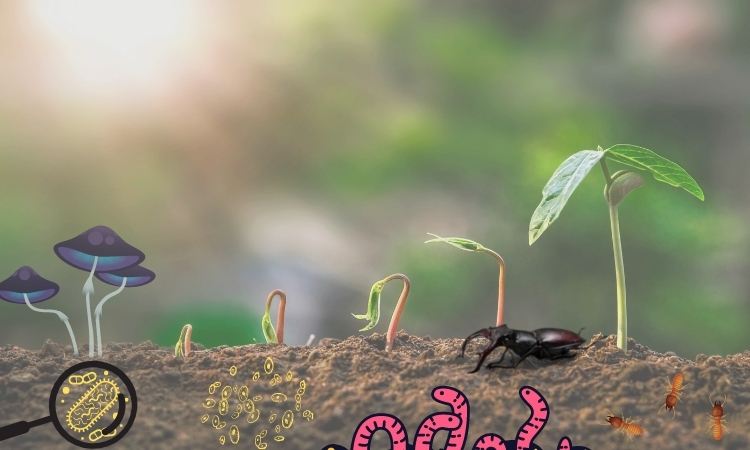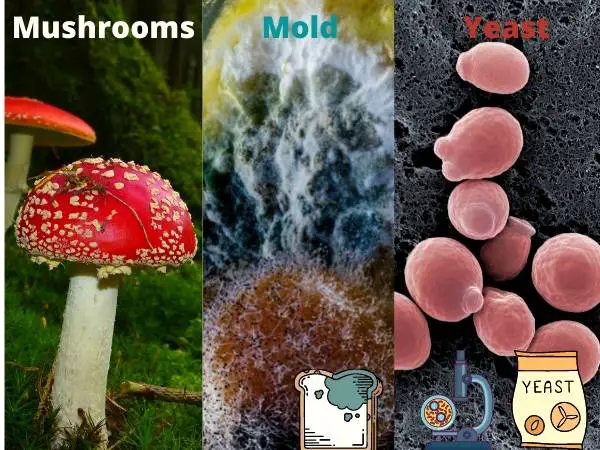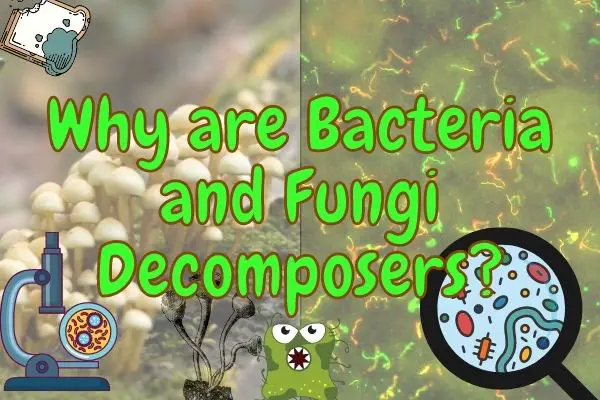Bacteria and fungi are called decomposers because they break down dead organic material into simple chemical nutrients, like carbon and nitrogen compounds, that can be used by plants and algae.
Being the most abundant decomposers on earth, bacteria and fungi play an extremely important role in the recycling of nutrients in ecosystems. They are present in any ecological niche on earth, and without them, we would not be here!
Bacteria and fungi do this mostly by releasing enzymes that break down organic materials externally, whereas animal decomposers (detritivores), like earthworms, eat organic material and digest them internally.
Dormant bacteria and fungi spores are present in air, soil, and water, waiting for the right conditions to germinate.
Bacteria are single-celled, microscopic organisms. They live almost everywhere. Some can tolerate freezing temperatures, while others can survive in boiling water.
Aerobic bacteria need oxygen to function, while anaerobic bacteria only function in oxygen-poor conditions.
Most bacteria are adapted to live in a specific environment and consume specific compounds, some even synthesize their own food, so there are millions of species with vastly different diets out there!1
Contents
Are bacteria consumers and decomposers?
Yes. Bacteria can be consumers and decomposers at the same time!
When bacteria gain their energy and nutrients from living organic matter they are consumers, whereas bacteria that feed on dead organic matter are decomposers.
The bacteria that make plants, humans, and animals sick would be regarded as consumers as they “eat” living organisms, whereas those existing in the soil would be primarily decomposers.
Are All Bacteria Decomposers?
Not all bacteria are decomposers. Bacteria that feed on live organisms are consumers without necessarily being decomposers.
Additionally, bacteria that gain their energy and nutrients by breaking down inorganic chemical compounds are known as chemoautotrophs, while photosynthetic bacteria gain their energy from the sun, like plants. Chemoautotrophic and photosynthetic bacteria are producers rather than consumers or decomposers.
Chemosynthetic bacteria do not consume other organic matter in order to gain energy. Instead, they use chemicals from the environment to produce food.
Bacteria that get their nutrients from living organisms can be either pathogenic or mutualistic consumers, depending on whether they harm or help the organisms they feed on.
Examples of common pathogenic bacteria in humans include Staphylococcus aureus, which can infect wounds, Salmonella species, which cause food poisoning, and Streptococcal species, which can cause a range of respiratory tract infections3.
Nitrogen-fixing bacteria, also known as rhizobia, form symbiotic associations with legume plant roots4. These are visible as little white nodules on the fine root hair. The bacteria get carbon compounds from the plant and the bacteria convert nitrogen from the air into ammonium, which the plant can absorb5.

Chemoautotrophs can gain energy from breaking down nitrogen, sulfur, iron, or hydrogen compounds. Even though they are not technically decomposers, some of them play an important role in the decomposition process.
For example, nitrifying bacteria in the soil transform the ammonium found in feces to nitrite and nitrate, which are important nutrients for plants4.
Cyanobacteria, green bacteria, and purple sulfur bacteria are examples of bacteria that contain chlorophyll and can photosynthesize, just like plants1. Photosynthetic bacteria in the soil are important for fixing atmospheric nitrogen and carbon in the soil for plants to absorb4.
What types of bacteria are the most important decomposers?
The most important decomposing bacteria, or at least the most abundant ones, are those found in soil and in the sea bed, or in our feces (very important for us and other animals!).
Actinomycetes are bacteria that give soil that earthy smell. They look like gray spider webs between decaying plant matter. They are important for decomposing organic matter in soil because they can break down complex plant compounds, like chitin and cellulose.4

In feces, bacteria break down undigested organic matter such as fats and sugars. In anoxic conditions, for example, when large amounts of feces are stored in containers, decomposition by anaerobic bacteria leads to the production of methane and other bad-smelling gasses.6
Some bacteria that are essential for many ecosystems also play an important role in the decomposition of carcasses.
When an animal dies, bacteria already present in the gut digest the intestines and surrounding tissues.
As the environment inside the carcass changes, aerobic bacteria start to decline and anaerobic bacteria take over, producing gasses such as hydrogen sulfide, methane, cadaverine, and putrescine, which are responsible for the bloating and bad smells of a carcass.
These smells attract detritivores, such as flies, and scavengers, such as vultures, which then speed up the decomposition process.7, 8
How do single celled decomposers get energy?
Bacteria and fungi are both able to produce energy through a process called cellular respiration. This process involves the use of oxygen to convert glucose or other simple sugars and amino acids into energy, allowing the cells to function and grow.
The nutrients that they use for respiration comes from the organic matter that they decompose. For example, some fungi and bacteria may release cellulase enzymes to break down the cell wall of plants (this will not work on animals as they do not have a cell wall!).
The cellulose is broken down into simple sugars that the bacteria and fungi can then easily take up through their cell envelope and convert to energy inside the cell.
However, not all single celled decomposers use respiration to get their energy. This only works when oxygen is present, but similar processes exist for conditions without oxygen.
Many of the bacteria and yeasts that cause rots and spoils in fruits prefer to get their energy from a process known as “fermentation” that you might know from beer,wine or the yeast used in cider making!
The fermentation process extracts energy from the sugars in the fruits without the need for oxygen, but does result in a waste product in the form of alcohol or organic acids such as lactic acid. As such, it does not lead to “complete” decomposition of the material.
For example, bacteria living in crevices of the deepest oceans do not get much oxygen, so they will have to use other molecules instead.
These bacteria are called chemosynthetic bacteria and I wrote about them here.
They can work completely without oxygen, and some can even survive without organic material at all (these are not decomposers though).
Fungi as Decomposers
Fungi can range in shape and size from microscopic single-celled organisms to large multicellular organisms, such as giant puffballs that can grow up to 5 feet (150 cm) in diameter. Mushrooms and toadstools are the most well-known fungi.
These “macrofungi” are, however, just the fruiting body of the fungus, with the actual fungus stretching up to several kilometers underground!
Other types of fungi include yeasts, rusts, mildews, and mold and they all eat different things.

They are more prevalent in warm, humid environments with lots of organic material, such as temperate and tropical regions. You probably already know some from your kitchen, or maybe even your camping gear?
Very few fungi occur in deserts and other areas with little or no organic matter. Read about what decomposing fungi eat in the dessert and other ecosystems here!
Most fungi in the Arctic and Antarctic regions are found in symbiosis with algae or bacteria in the form of lichens.
Most fungi are aerobic but anaerobic fungi occur in the digestive tract of ruminants where they break down cellulose through fermentation, and all fungi need to get their organic materials from an external source.2
Are fungi producers, consumers and decomposer or all of them?
Fungi obtain their nutrients from organic matter and can therefore only be consumers or decomposers.
Fungi do not have chlorophyll and cannot photosynthesize. Therefore, they are never producers.
Fungi may live directly from living animals or plants, but most of them break down dead plant matter for their nutrients. This makes them very important decomposers.
What types of fungi are the most important decomposers?
Wood-rotting fungi are critical to the decomposition of plant material. They have the unique ability to break down lignin, the compound that makes plant material woody and difficult to digest. By removing lignin, wood-rotting fungi make plant material easier to break down for other decomposers.9
While bacteria are the main decomposers of carnivore dung, fungi play a big role in the breakdown of herbivore dung.
Herbivores incidentally swallow fungi spores while they feed. The spores remain inactive inside the animal’s gut and then germinate as soon as they get deposited with the animal droppings.
They mature and form spores that spread to the surrounding vegetation where they get ingested by feeding animals and the cycle repeats.10
Various fungi play a role in the decomposition of carcasses, often visible as distinctive mildew spots forming a few days after death.
However, many more fungi species, most invisible to the human eye, are involved in different stages of carcass decomposition.
Postmortem fungi grow on the soil surrounding the carcass, sometimes long after the carcass has been decomposed or removed. These fungi can be used to detect graves or the original locations of carcasses that have been moved.11
Are some fungi not decomposers?
While many fungi are decomposers, some can infect live hosts. Pathogenic fungi are responsible for many plant diseases and great losses in agriculture and forestry industries. For example, ergot causes disease in grass crops, such as rye. Fungal diseases in humans include athlete’s foot, ringworm, and candida infection.2
However, not all fungal infections are pathogenic. Some can form mutualistic relationships with plant roots.
Mycorrhizae are the mutualistic association of plant roots and fungi. Many plant species like orchids, conifers, and beech trees, rely on mycorrhizal fungi to gain nutrients. For example, orchid seeds, unlike most other plant seeds, do not have a nutrient store.
Instead, they depend on the energy obtained from mycorrhizal fungi to germinate. Pinesaps are unique plants that lack chlorophyll. Since they cannot photosynthesize, they are completely dependent on mycorrhizal fungi to obtain energy and nutrients.2
A small number of fungi are predators of microorganisms such as amoebas, and roundworms. They trap the organisms either by secreting adhesives on their surface or by producing rings that constrict as they pass through. The hyphae of the fungi then penetrate their prey and digest them from inside.2
Conclusion
A wide diversity of bacteria and fungi, most of them invisible, surround us every day. These organisms are involved in a range of critical ecological functions and, while we hardly ever give them a second thought, we cannot imagine a world without them.
References
- Rogers, K. and Kadner, R. J. 2020. Bacteria. Encyclopedia Britannica. https://www.britannica.com/science/bacteria
- Moore, D., Alexopoulos, C. J. and Ahmadjian, V. 2020. Fungus. Encyclopedia Britannica. https://www.britannica.com/science/fungus
- Healthgrades. 2021. Bacterial diseases. https://www.healthgrades.com/right-care/infections-and-contagious-diseases/bacterial-diseases
- Ingham, E.R. Soil bacteria. United States Department of Agriculture website. https://www.nrcs.usda.gov/wps/portal/nrcs/detailfull/soils/health/biology/?cid=nrcs142p2_053862
- Wang, Q., Liu, J., and Zhu, H. 2018. Genetic and molecular mechanisms underlying symbiotic specificity in legum-rhizobium interactions. Frontiers in Plant Science. 9: 3131. https://www.frontiersin.org/articles/10.3389/fpls.2018.00313/full#:~:text=Legumes%20are%20able%20to%20form,be%20used%20by%20the%20plant.
- Girard, M., Palacios, J.H., Belzile, M., Godbout, S., and Pelletier, F. 2013. Biodegradation in Animal Manure Management. IntechOpen Book Series. https://www.intechopen.com/chapters/45120
- Mondor, E. B., Tremblay, M. N., Tomberlin, J. K., Benbow, E. M., Tarone, A. M. & Crippen, T. L. 2012. The Ecology of Carrion Decomposition. Nature Education Knowledge. 3(10):21. https://www.nature.com/scitable/knowledge/library/the-ecology-of-carrion-decomposition-84118259/
- Hyde, E.R., Haarmann, D.P., Lynne, A.M., Bucheli, S.R., and Petrosino, J.F. 2013. The Living Dead: Bacterial Community Structure of a Cadaver at the Onset and End of the Bloat Stage. PLoS ONE. 8 (10): e0077733. https://doi.org/10.1371/journal.pone.0077733
- Blanchette, R. 1991. Delignification by Wood-Decay Fungi. Annual Review of Phytopathology. 29: 281–403. doi:10.1146/annurev.py.29.090191.002121.
- Lepp, H. 2013. Dung fungi. Australian National Botanical Gardens. https://www.anbg.gov.au/fungi/ecology-dung.html




